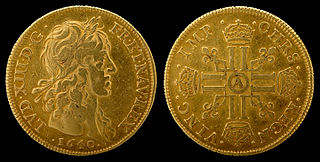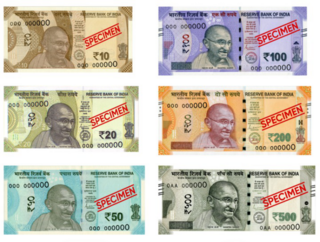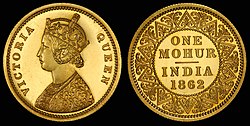
The svenska riksdaler was the name of a Swedish coin first minted in 1604. Between 1777 and 1873, it was the currency of Sweden. The daler, like the dollar, was named after the German Thaler. The similarly named Reichsthaler, rijksdaalder, and rigsdaler were used in Germany and Austria-Hungary, the Netherlands, and Denmark-Norway, respectively. Riksdaler is still used as a colloquial term for krona, Sweden's modern-day currency.

Rupee is the common name for the currencies of India, Mauritius, Nepal, Pakistan, Seychelles, and Sri Lanka, and of former currencies of Afghanistan, Bahrain, Kuwait, Oman, the United Arab Emirates, British East Africa, Burma, German East Africa, and Tibet. In Indonesia and the Maldives, the unit of currency is known as rupiah and rufiyaa respectively, cognates of the word rupee.

The Louis d'or is any number of French coins first introduced by Louis XIII in 1640. The name derives from the depiction of the portrait of King Louis on one side of the coin; the French royal coat of arms is on the reverse. The coin was replaced by the French franc at the time of the revolution and later the similarly valued Napoléon. The actual value of the coins fluctuated according to monetary and fiscal policy, but in 1726 the value was stabilized.

The Indian rupee is the official currency in India. The rupee is subdivided into 100 paise. The issuance of the currency is controlled by the Reserve Bank of India. The Reserve Bank manages currency in India and derives its role in currency management based on the Reserve Bank of India Act, 1934.

The Sri Lankan Rupee is the currency of Sri Lanka. It is subdivided into 100 cents, but cents are rarely seen in circulation due to its low value. It is issued by the Central Bank of Sri Lanka. The abbreviation Re (singular) and Rs (plural) is generally used, the World Bank suggests SL Rs as a fully disambiguating abbreviation for distinction from other currencies named "rupee".

The ducat coin was used as a trade coin in Europe from the later Middle Ages to the 19th century. Its most familiar version, the gold ducat or sequin containing around 3.5 grams of 98.6% fine gold, originated in Venice in 1284 and gained wide international acceptance over the centuries. Similarly named silver ducatons also existed. The gold ducat circulated along with the Florentine florin and preceded both the modern British pound sterling and the United States dollar.

The tola also transliterated as tolah or tole, is a traditional Ancient Indian and South Asian unit of mass, now standardised as 180 grains or exactly ⅜ troy ounce. It was the base unit of mass in the British Indian system of weights and measures introduced in 1833, although it had been in use for much longer. It was also used in Aden and Zanzibar: in the latter, one tola was equivalent to 175.90 troy grains.

The Coinage of India began anywhere between early 1st millennium BCE to the 6th century BCE, and consisted mainly of copper and silver coins in its initial stage. The coins of this period were Karshapanas or Pana. A variety of earliest Indian coins, however, unlike those circulated in West Asia, were stamped bars of metal, suggesting that the innovation of stamped currency was added to a pre-existing form of token currency which had already been present in the Janapadas and Mahajanapada kingdoms of the Early historic India. The kingdoms that minted their own coins included Gandhara, Kuntala, Kuru, Magadha, Panchala, Shakya, Surasena, Surashtra and Vidarbha etc.

The rupia was the currency of Portuguese India sometime after 1668 until 1958. Prior to 1668, the currency unit was Xerafim. In 1666, the Portuguese administration struck a silver coin calling it double xerafin and this was declared equal to a rupia in circulation in India outside of Portuguese possessions. A xerafim was a convertible subunit of rupia, and it was unique to Portuguese colonies in India. One rupia equalled two xerafims.

The real was the unit of currency of Portugal and the Portuguese Empire from around 1430 until 1911. It replaced the dinheiro at the rate of 1 real = 840 dinheiros and was itself replaced by the escudo at a rate of 1 escudo = 1000 réis. The escudo was further replaced by the euro at a rate of 1 euro = 200.482 escudos in 2002.

The history of the rupee traces back to ancient times in the Indian subcontinent. The mention of rūpya by Pāṇini is seemingly the earliest reference in a text about coins. The term in Indian subcontinent was used for referring to a coin.

The Rupie was the currency of German East Africa between 1890 and 1916, continuing to circulate in the Tanganyika Territory until 1920.

Silver coins are one of the oldest mass-produced form of coinage. Silver has been used as a coinage metal since the times of the Greeks; their silver drachmas were popular trade coins. The ancient Persians used silver coins between 612–330 BC. Before 1797, British pennies were made of silver.

The Netherlands Indies guilder was the unit of account of the Dutch East Indies from 1602 under the United East India Company, following Dutch practice first adopted in the 15th century. A variety of Dutch, Spanish and Asian coins were in official and common usage. After the collapse of the VOC at the end of the 18th century, control of the islands reverted to the Dutch government, which issued silver 'Netherlands Indies' guilder and fractional silver and copper coins until Indonesian independence in 1945.

A dam was a small Indian copper coin. The coin was first introduced by Sher Shah Suri during his rule of India between 1540 and 1545, along with Mohur, the gold coin and Rupiya the silver coin. Later on, the Mughal Emperors standardised the coin along with other silver (Rupiya) and gold (Mohur) coins in order to consolidate the monetary system across India. A rupee was divided into 40 dams.

The rigsdaler specie was a unit of silver currency used in Norway from 1544, renamed as the speciedaler in 1816 and used until 1873. Norway used a common reichsthaler currency system shared with Denmark, Hamburg and Schleswig-Holstein until 1873 when the gold standard was implemented in Scandinavia and the German Empire.

Coinage under British governance of the Indian subcontinent can be divided into two periods: East India Company (EIC) issues, pre-1835; and Imperial issues struck under direct authority of the crown. The EIC issues can be further subdivided into two subcategories: the Presidency issues, which comprise separate Madras Presidency, Bombay Presidency, and Bengal Presidency issues; and uniform coinage for all British territories from 1835 to 1858. Imperial issues bear obverse portraits of Queen Victoria, Edward VII, George V, and George VI. No British India coins were issued during the brief reign of Edward VIII.

The Indian Two paise, is a former denomination of the Indian Rupee. The 2 coin equals 1⁄50 of the Indian Rupee. The symbol for Paisa is.

The Indian Three paise, is a former denomination of the Indian Rupee. The 3 coin equals 3⁄100 of the Indian Rupee. The symbol for paisa is.

The Indian 1-rupee coin (₹1) is an Indian coin worth one Indian rupee and is made up of a hundred paisas. Currently, one rupee coin is the smallest Indian coin in circulation. Since 1992, one Indian rupee coins are minted from stainless steel. Round in shape, the one rupee coins weighs 3.76 grams, has a diameter of 21.93-millimetre (0.863 in) and thickness of 1.45-millimetre (0.057 in). In independent India, one rupee coins was first minted in 1950 and is currently in circulation.






















